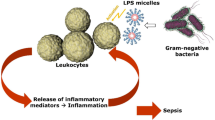Abstract
The amebocytes of horseshoe crab (Limulus) hemolymph contain a coagulation system highly sensitive to bacterial endotoxins. Limulus amebocyte lysate (LAL) reactive material derived from cuproammonium rayon membranes, however, is not an endotoxin and acts upon the alternative pathway in the coagulation cascade found in Limulus amebocyte lysate. This study confirmed these facts by using the coagulation system of Limulus without factor G, which is a substrate of the alternative pathway. LAL reactive material lingered in the circulation for a relatively long time. In acute hemodialysis, its plasma concentration increased by an average of 100 pg/ml with each dialysis and eventually reached a plateau of approximately 300 pg/ml. In patients with chronic renal failure under regular hemodialysis, the mean level of LAL reactive material was 330.0±8.0 pg/ml before hemodialysis which increased by 70.6±20.7 pg/ml after four hours of hemodialysis.
Similar content being viewed by others
References
Carson LA, Petersen NJ. LAL-reactive material associated with hemodialysis membranes. In Watson SW, Levin J, Novitsky TJ, eds. Endotoxins and their detection with the Limulus amebocyte lysate test. New York: Alan R. Liss, Inc. 1982; 217–230.
Pearson FC, Weary H, Bohon J. Detection of Limulus amebocyte lysate reactive material in capillary flow hemodialyzers. In Watson SW, Levin J, Novitsky TJ, eds. Endotoxins and their detection with the Limulus amebocyte lysate test. New York: Alan R. Liss, Inc. 1982; 247–260.
Sakashita K, Tsutsui T, Itoh A, Yamasaki C, Masuko K, Isozaki T. Study on Limulus amebocyte lysate-reaction material (LAL-RM) arising from non-used dialyzer. Jpn J Artif Organs 1984; 13: 780–783.
Pearson FC, Bohen J, Lee W, Bruszer G, Sagona M, Dawe R, Jakubowski G, Morrison D, Dinarello C. Comparison of chemical analyses of hollow-fiber dialyzer extracts. Artificial Organs 1984; 8: 291–298.
Mikami T, Nagase T, Matsumoto K, Suzuki M, Suzuki S. Studies on relationship between Limulus lysate gelation and pyrogenic activities of several simple polysaccharides. Jpn J Med Sci Biol 1983; 36: 124–125.
Kakinuma A, Asano T, Torii H, Sugino Y. Gelation of Limulus amebocyte lysate by an antitumor (1→3)-β-D-glucan. Biochemical and Biophysical Research Communications 1981; 101: 434–439.
Morita T, Tanaka S, Nakamura T, Iwanaga S. A new (1→3)-β-D-glucan-mediated coagulation pathway found in Limulus amebocyte. Febs Letters 1981; 129: 318–321.
Tamura H, Obayashi T, Takagi K, Tanaka S, Nakahara C, Kawai T. Perchloric acid treatment of human blood for quantitative endotoxin assay using synthetic chromogenic substrate for horseshoe crab clotting enzyme. Thromb Res 1982; 27: 51–55.
Tanaka S, Nakamura T, Morita T, Iwanaga S. The reaction mechanism of “Limulus test”: On the alternative activation pathway mediated by (1→3)-β-D-glucan. Jpn J Med Sci Biol 1982; 35: 109–114.
Author information
Authors and Affiliations
Rights and permissions
About this article
Cite this article
Yoshioka, T., Ikegami, K., Ikemura, K. et al. A study on limulus amebocyte lysate (LAL) reactive material derived from dialyzers. The Japanese Journal of Surgery 19, 38–41 (1989). https://doi.org/10.1007/BF02471564
Received:
Issue Date:
DOI: https://doi.org/10.1007/BF02471564




